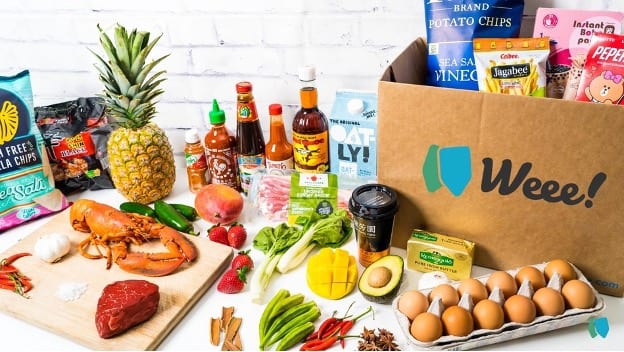
Today’s online grocers are in a difficult position, with two competing trends pulling them in opposite directions.
On the one hand, rising demand for digital convenience provides a powerful tailwind for eGrocers that deliver to consumers’ doors. On the other, sky-high inflation creates a disincentive for many would-be-customers to purchase from these merchants, unwilling to pay the extra costs necessary to make the economics of delivery work.
The most recent U.S. Bureau of Labor Statistics (BLS) Consumer Price Index (CPI) report revealed that, in February, prices for groceries increased 8.6% year over year, the greatest 12-month increase since Jimmy Carter was in office.
Read more: Highest Grocery Inflation in 40 Years has Consumers Running to Big-Name Brands
Online grocery prices specifically are also on the rise, with prices jumping a record-high 7.6% year over year in February, according to data released earlier this month by software company Adobe Inc.
See more: Online Grocery Prices in US Jump 7.6% in February Excluding Delivery
In an effort to reconcile these two opposing forces, Weee, an eGrocer specializing in delivery of groceries from a range of ethnicities, is leveraging artificial intelligence (AI) and automation to keep prices low while offering a broad assortment of products, Weee Founder and CEO Larry Liu told PYMNTS in an interview.
“A primary focus of our AI innovations will be on improving product discovery for customers to better serve them recommendations on products and content they are likely to enjoy,” said Liu. “The increased warehouse automation will enable us to continue to manage and ship the vast product assortment efficiently and maintain another one of our key differentiators: affordability.”
Carving out a Niche
At the end of February, the company announced a $425 million Series E fundraise, with investors taking interest in the company’s differentiated model, targeting groups “massively underserved in the U.S.,” according to Lydia Jett, managing partner at the lead investor Softbank Investment Advisors.
Certainly, with so many eGrocers entering the space attempting to seize on the rising demand, those that can set their offerings apart from the others in the category have the opportunity to pull ahead.
“The ethnic grocery and food market is currently $360+ billion, and within this market, Asian and Hispanic populations in the U.S. are the fastest-growing,” said Liu. “So that is where we have focused and will continue to explore additional opportunities.”
Overall, the United States continues to lag comparable markets in eGrocery adoptions. PYMNTS research from the November study “What U.K. Consumers Expect From Their Grocery Shopping Experiences,” a PYMNTS and ACI Worldwide collaboration, found that about a third of U.K. consumers prefer shopping for groceries online to shopping for groceries in stores, while only 18% of U.S. consumers prefer the same.
Read more: 52% of UK Consumers Shop for Groceries Online More Than They Did in 2020
Too Fast, Too Furious
One polarizing topic in the online grocery space is that of ultrafast delivery. Weee, for its part, schedules deliveries in advance.
Services promising 15-minute delivery have been facing a range of challenges, although high demand provides a valuable boost. One report found that these services’ losses can amount to as much as $20 per order on average.
See more: Ultrafast Grocers’ Losses Mount in the Face of an Uncertain Future
One such ultrafast grocer, Buyk, announced Thursday (March 17) that it has filed for bankruptcy and that it is ceasing its operations, after, according to a statement from CEO James Walker, “diligently explor[ing] all possible options and partnerships to restructure Buyk and keep the business going.” The Russian-backed company saw its funding dry up due to Russia sanctions.
Read more: Instant Grocery Delivery Service Buyk Closes, Files Bankruptcy Over Russian Sanctions
Liu said he is neither all-in on the model nor blind to its shortcomings.
“We are certainly seeing some degradation in the funding environment for the ultrafast convenience providers, but overall, online grocery adoption and customer growth clearly demonstrates that the eCommerce grocery market is underpenetrated and has tremendous potential,” he said.
In Context
Looking ahead, Weee plans to leverage contextual commerce, using entertaining content to drive sales outside the traditional confines of the company’s online store.
“Content will play an increasingly prominent role in our immersive social shopping experience as we explore the intersections of life and food more holistically,” he said.
Contextual commerce is certainly a growing trend in online grocery. Instacart, for example, announced Wednesday (March 16) the launch of shoppable recipes through content providers including TikTok, Tasty and select Hearst Magazines publications.
See more: Instacart Gets into Contextual Commerce with Shoppable Recipe Launch
Another leader in the shoppable entertainment space in grocery has been Walmart, whose content partners include media giants Meredith Corporation and Buzzfeed.
Read more: Walmart Partners With Meredith for AI-Informed Contextual Grocery Commerce
Walmart Grows Its Shoppable Content Empire With Buzzfeed Partnership Expansion
The company’s growth strategy takes a connected view of commerce, not only in terms of leveraging contextual integrations but also in terms of taking on a greater share of consumers’ total food spending. Liu highlighted the company’s acquisition of Asian food delivery company RICEPO in 2021 as an example of expansion into new categories.
“The online grocery experience will be much more than just groceries,” he said. “It will become a more comprehensive ‘food at home’ experience. Video content and social integrations, which are key areas of innovation for Weee, will be layered on top of those capabilities to provide a totally next-generation online food experience.”